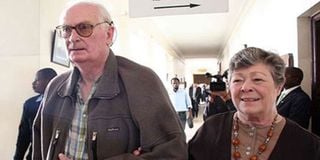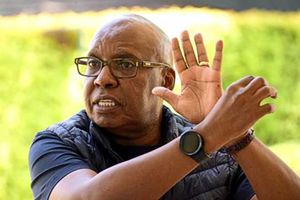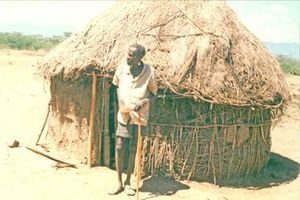
Lord Delamere with his wife Lady Maryin Nairobi in a past photo.
In the vast expanse of the 49,000-acre Soysambu estate, nestled on the shores of Lake Elementaita, the last glimmers of colonial privilege flickered within Lord Delamere’s final stronghold. For generations, the Delamere family ruled this land with an unyielding grip, their wealth and influence stretching across Kenya like an unbroken thread of imperial dominance.
Occasionally, trespassers were met with the barrel of a gun. Yet, this week, a storied chapter quietly came to an end with the death of Hugh George Cholmondeley, Fifth Baron Delamere. In Naivasha, he reigned. But now, another piece of colonial legacy has slipped into history.
The colonial aristocracy resided within the storied expanse of Soysambu, the final bastion of the White Highlands' dominion. Nestled amidst its verdant grounds stands the statue of the Third Baron Delamere, uprooted from its original location in Nairobi following independence. Here, it presides as a poignant emblem of an unvanquished legacy, a silent symbol of the bygone era that once sought to assert its authority over the land. This monument, and the family cemetery, embodies the lingering spectre of colonial ambitions, an enduring reminder of a territory that was claimed but never fully subdued.
It was here where Lord Delamere spent his time. In later years, he preferred to be called Hugh, the weight of the Delamere title and its symbolism in independent Kenya weighing him down. Had his son, the gun-loving Tom Cholmondeley, lived, he would have inherited the title. But Tom, who embodied both the oddity and the violence that marked his family's lineage, died eight years prior, his death leaving a void in the Delamere dynasty.
Hugh, a graduate of Cambridge College in agriculture, had always been a farmer following the footsteps of his great-grandfather – the third baron Delamere who had sold his vast estate in Britain to invest in Africa. Whether the Delamere’s made money depends on the yardsticks of comparison.
But the Fifth Lord Delamere died while grappling with the difficulties of running a complex ranch caught between political and environmental pressures. In Soysambu, more than anywhere else, these obstacles danced like inseparable twins. A decade ago, in his pursuit of an equilibrium, Lord Delamere had judiciously partitioned the Sh5 billion estate into more manageable segments. Then, the man he thought would run the estate, Tom Cholmondeley, died.
For many years, Lord Delamere maintained his cherished Boran cattle, a symbol of resilience in the estate. It is a breed that had weathered the rigours of the unforgiving terrain over the ages – and sustained the Delamere’s income from the beef industry. But in Soysambu, the Boran cattle competed for grazing rights alongside the zebras, embodying the delicate balance of nature's competition. Unlike his father, he could no longer cull the zebras.
Had Tom chosen a quiet life, his father Lord Delamere’s world would have been spared scrutiny and eventual prying eyes of the media. Yet, Tom resided firmly within the confines of his own imagination — a vision of a settler colony alive with grandeur and ambition.
Always clad with a Luger pistol in one hand and a Winchester rifle in the other, Tom roamed the vast estate like a feudal lord, ruling over it as though it were his personal dominion—a fiefdom dictated by his every whim. His reign of violence, however, did not go unnoticed, eventually dragging Lord Delamere’s name into the corridors of justice. The brutal slayings of stonemason Robert Njoya Mbugua and Kenya Wildlife Service ranger Samson Ole Sisina were used to showcase Delameres' fierce defence of their sprawling lands. It was these two murders that etched the Delameres' ruthless grip on their estate into public consciousness. It triggered uproar across the country, forcing Kenyans to once again grapple with the stark remnants of racial inequity and the enduring shadow of white privilege.
There was a history to it. Lady Delamere, Tom’s mother, always slept with a loaded revolver under her pillow. In his twilight, Lord Delamere struggled to undo the damage done by his son. It is said that after his son was found guilty and jailed, Lord Delamere’s world almost collapsed. He asked his lawyers to reach out to the families of the victims in search of closure. To the family of the KWS ranger, he parted with 50 cows and is said to have supported Mbugua’s wife to start a business.
Tom’s death silenced notoriety. But he had contributed to the family’s history. The Third Baron Delamere first arrived in Kenya with a singular ambition — to turn the colonised lands into a “white man’s country”. For 70 years, they nearly succeeded, led by the Third Baron Delamere, affectionately known as “D”. “D” was eccentric but courageous; his temper matched his red hair and reputation for intolerance,” one biographer wrote about him.
He had left his sprawling estate in Cheshire in 1897, embarking on an expedition to Kenya with a caravan of 200 camels and 100 porters, driven by his passion for lion hunting. Delamere became the chief architect of white settlement in Kenya, positioning himself at the helm of British imperial ambitions. In 1906, the colonial government leased to him the Maasai grazing lands in Naivasha land where he experimented with wheat and dairy industry.
Stories about the Fifth Baron Delamere were also stuff for the legend. It is claimed that fate brought him to Lady Ann, daughter of Sir Patrick Renison, a former colonial governor of Kenya. During a dinner party hosted by Diana Caldwell Broughton – another scandalous soul of the Happy Valley – Hugh and Ann were paired to balance a dinner table. Diana, is a story on her own. She carried her femininity like a strength. She refused to be characterised by the scandals of Happy Valley, and maintained her place in the circle of aristocrats infamous for their debauchery, drug use, and ultimately, murder. In 1941, Diana’s elderly husband shot her lover, in an event that shook the empire. She later married the Delameres.
With the passing of Hugh George Cholmondeley, the Delamere name now fades into the annals of history – at least in Kenya. The aristocratic families, which had maintained ties to the former colony, have continued to diminish leaving behind an empire they had hoped to call home.
At Soysambu, the last of the aristocrats has taken a final bow.
@Johnkamau1






